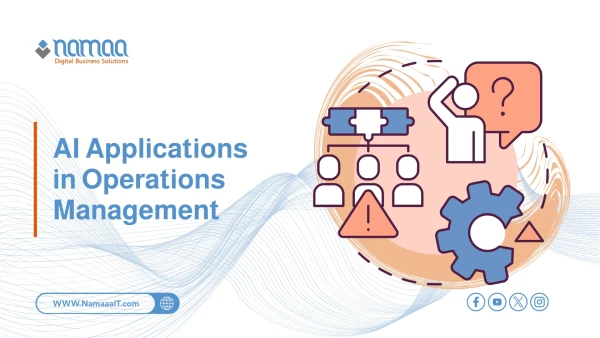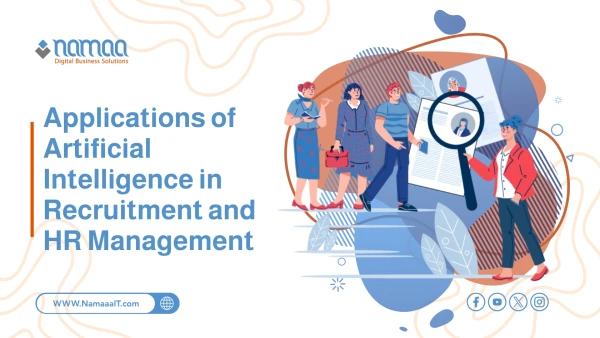Companies are leveraging artificial intelligence (AI) technologies in supply chains, from planning and production to inventory management, distribution, and logistics.
For example, AI can enhance demand forecasting accuracy, helping reduce waste and increase customer satisfaction. It can also optimize shipping routes and reduce delivery times, boosting logistical efficiency.
Moreover, AI is used to monitor performance and identify weaknesses in the supply chain, enabling companies to make data-driven decisions to improve operations. It also enhances communication with suppliers and customers by automating routine interactions and providing accurate, real-time information.
In this article, we will explore the most important AI applications in supply chain management, focusing on the benefits these technologies offer and the potential challenges companies may face when adopting them.
Using AI in Supply Chain Management
Artificial Intelligence (AI) is no longer just a supportive tool—it has become a strategic element in developing modern supply chains. Today’s supply chains rely on massive amounts of data from diverse sources like sales systems, warehouses, transportation, and suppliers. In this context, AI emerges as a powerful solution capable of gathering this data, analyzing it in real time, and making accurate decisions that enhance efficiency, reduce errors, and improve overall supply chain performance.
Instead of managing operations based solely on intuition or historical data, AI provides predictive, data-backed insights, enabling rapid responses to unexpected events such as demand changes or supply disruptions. This shift toward smart interaction has transformed the nature of supply chain operations, making decision-making more precise and flexible. Here are the top applications of AI in supply chains:
1. Smart Demand Forecasting and Inventory Availability Optimization
Demand forecasting is a core element of supply chain management, and it has significantly advanced with the help of AI. Smart systems use machine learning algorithms to analyze historical sales data, customer behavior, seasonal factors, and even global economic trends to predict future demand more accurately.
These precise forecasts help companies manage inventory more efficiently. For example, if the algorithms predict a surge in demand for a specific product during a certain period, early action can be taken to ensure adequate stock without overstocking or running out. This, in turn, reduces storage costs and prevents lost opportunities due to product unavailability.
2. AI and Logistic Performance Optimization
Logistics operations—such as warehousing, shipping, distribution, and final delivery—are key parts of any supply chain. Through AI, these activities can become more streamlined and efficient. Companies use route optimization tools to identify the fastest and most cost-effective delivery paths. These analyses incorporate variable factors like traffic conditions, weather, and port or border delays.
AI technologies also enhance fleet management by tracking vehicle conditions, scheduling predictive maintenance, and reducing fuel consumption. These applications lower operational costs and improve delivery speed, benefiting both companies and end customers.
3. Decision Support and Crisis Management
A persistent challenge in supply chains is dealing with crises and unexpected events like natural disasters, pandemics, or sharp market fluctuations. AI is now used to develop risk prediction models that anticipate such events based on early indicators, allowing teams to prepare in advance and activate contingency plans.
AI-driven decision support systems analyze alternatives and suggest optimal solutions during disruptions. For example, if a sea shipment is delayed at a port, smart systems might recommend switching to land or air freight based on a quick analysis of time, cost, and availability.
4. Enhancing Supplier and Customer Relationships with AI
Supplier and customer relationships are vital in supply chains. AI is used to analyze supplier performance based on punctuality, product quality, and transportation costs, and then recommend future collaboration or changes when needed.
At the customer experience level, companies use AI tools to understand customer behavior more deeply by tracking purchases, product reviews, and complaints. This enables companies to offer personalized services like targeted promotions or product recommendations, enhancing loyalty and increasing conversion rates.
5. Smart Automation of Warehouses and Distribution Centers
AI plays a crucial role in improving efficiency and reducing human dependency in routine warehouse and distribution center tasks. AI-powered robots are used for storing, sorting, and preparing goods for shipment quickly and accurately.
Computer vision systems integrated with AI monitor inventory levels, check product quality, and detect errors or damage. These systems help reduce waste and increase productivity, especially for companies handling high order volumes, such as e-commerce platforms.
6. Integrating AI with the Internet of Things (IoT)
AI becomes even more powerful when combined with other technologies, especially the Internet of Things (IoT). By using smart, network-connected sensors, companies can collect real-time data on container temperature, shipment location, and equipment status.
This data is analyzed using AI to detect anomalies and take immediate action. For instance, if the temperature of a shipment containing food or pharmaceuticals rises above safe levels, an automatic alert is sent to responsible personnel to act before the goods are damaged. This type of smart monitoring helps protect quality and reduce losses.
Read also: AI Applications in Operations Management
Challenges of Implementing AI in Supply Chains
Despite the vast opportunities AI offers for improving supply chain performance, there are several real-world challenges that organizations face when trying to implement it. One of the main challenges is:
Lack of high-quality data: AI algorithms rely on accurate and structured data to deliver reliable results. However, many companies struggle with unstandardized data structures or outdated, disconnected systems, hindering the full use of smart analytics.
High initial implementation costs: Applying AI technologies requires substantial investments in tech infrastructure, such as cloud computing, system integration, and staff training on analytics tools and smart systems.
Shortage of specialized talent: Some companies—especially small and medium-sized ones—may lack skilled professionals in fields like machine learning, big data analytics, or data science.
Privacy and cybersecurity concerns: As modern supply chains rely on connected networks and IoT devices, any security breach can directly affect operations and data confidentiality.
Ethical and transparency issues: There are concerns around AI ethics and algorithm transparency, as understanding how decisions are made can be difficult, making it challenging to trust the outcomes of smart systems.





.webp)
.webp)
